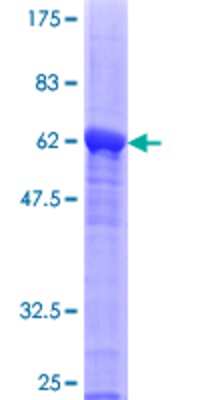Bcl G Products
Members in the Bcl-2 family are critical regulators of apoptosis by either inhibiting or promoting cell death. Bcl-2 homology 3 (BH3) domain is a potent death domain. BH3 domain containing pro-apoptotic proteins, including Bad, Bax, Bid, Bik, and Hrk, form a growing subclass of the Bcl-2 family. A novel BH3 domain containing protein was recently id...
Show More
38 results for "Bcl G" in Products
38 results for "Bcl G" in Products
Bcl G Products
Members in the Bcl-2 family are critical regulators of apoptosis by either inhibiting or promoting cell death. Bcl-2 homology 3 (BH3) domain is a potent death domain. BH3 domain containing pro-apoptotic proteins, including Bad, Bax, Bid, Bik, and Hrk, form a growing subclass of the Bcl-2 family. A novel BH3 domain containing protein was recently id...
Show More
Applications: WB, ICC/IF
Reactivity:
Human,
Mouse,
Rat
Recombinant Monoclonal Antibody
| Reactivity: | Human, Mouse, Rat |
| Details: | Rabbit IgG Monoclonal Clone #S06-3D8 |
| Applications: | WB, ICC/IF |
| Reactivity: | Human |
| Details: | Rabbit IgG Polyclonal |
| Applications: | IHC, WB, ICC/IF |
Applications: IHC, WB, ELISA, ICC/IF
Reactivity:
Human,
Mouse,
Rat
| Reactivity: | Human, Mouse, Rat |
| Details: | Rabbit IgG Polyclonal |
| Applications: | IHC, WB, ELISA, ICC/IF |
| Reactivity: | Human |
| Details: | Rabbit IgG Polyclonal |
| Applications: | IHC, WB |
Applications: WB, ELISA
Reactivity:
Human
| Reactivity: | Human |
| Details: | Mouse IgG1 kappa Monoclonal Clone #1F2 |
| Applications: | WB, ELISA |
| Reactivity: | Human |
| Details: | Mouse IgG1 kappa Monoclonal Clone #1D11 |
| Applications: | WB, ELISA, IP |
| Reactivity: | Human |
| Details: | Mouse IgG1 Monoclonal Clone #OTI6D1 |
| Applications: | IHC, WB |
| Applications: | WB, ELISA, MA, AP |
| Applications: | WB |
| Reactivity: | Hamster |
| Details: | Rabbit IgG Polyclonal |
| Applications: | WB |
| Applications: | AC |
| Reactivity: | Human |
| Details: | Mouse IgG1 Monoclonal Clone #OTI6D1 |
| Applications: | IHC, WB |
| Reactivity: | Human |
| Details: | Mouse IgG1 Monoclonal Clone #OTI6D1 |
| Applications: | IHC, WB |
| Reactivity: | Human |
| Details: | Mouse IgG1 Monoclonal Clone #OTI6D1 |
| Applications: | IHC, WB |
| Reactivity: | Human |
| Details: | Mouse IgG1 Monoclonal Clone #OTI6D1 |
| Applications: | IHC, WB |
| Reactivity: | Human |
| Details: | Mouse IgG1 Monoclonal Clone #OTI6D1 |
| Applications: | IHC |
| Reactivity: | Human |
| Details: | Mouse IgG1 Monoclonal Clone #OTI6D1 |
| Applications: | IHC |
| Reactivity: | Human |
| Details: | Mouse IgG1 Monoclonal Clone #OTI6D1 |
| Applications: | IHC |
| Reactivity: | Human |
| Details: | Mouse IgG1 Monoclonal Clone #OTI6D1 |
| Applications: | IHC |
| Reactivity: | Human |
| Details: | Mouse IgG1 Monoclonal Clone #OTI6D1 |
| Applications: | IHC |
| Reactivity: | Human |
| Details: | Mouse IgG1 Monoclonal Clone #OTI6D1 |
| Applications: | IHC |
| Reactivity: | Human |
| Details: | Mouse IgG1 Monoclonal Clone #OTI6D1 |
| Applications: | IHC |
| Reactivity: | Human |
| Details: | Mouse IgG1 Monoclonal Clone #OTI6D1 |
| Applications: | IHC |
| Reactivity: | Human |
| Details: | Mouse IgG1 Monoclonal Clone #OTI6D1 |
| Applications: | IHC |
| Reactivity: | Human |
| Details: | Mouse IgG1 Monoclonal Clone #OTI6D1 |
| Applications: | IHC |

![Western Blot: Bcl G Antibody (S06-3D8) [NBP3-19984] Western Blot: Bcl G Antibody (S06-3D8) [NBP3-19984]](https://resources.bio-techne.com/images/products/Bcl-G-Antibody-S06-3D8-Western-Blot-NBP3-19984-img0002.jpg)
![Western Blot: Bcl G Antibody [NBP1-91697] Western Blot: Bcl G Antibody [NBP1-91697]](https://resources.bio-techne.com/images/products/Bcl-G-Antibody-Western-Blot-NBP1-91697-img0010.jpg)
![Western Blot: Bcl G AntibodyBSA Free [NBP1-77223] Western Blot: Bcl G AntibodyBSA Free [NBP1-77223]](https://resources.bio-techne.com/images/products/Bcl-G-Antibody-Western-Blot-NBP1-77223-img0001.jpg)
![Western Blot: Bcl G Antibody [NBP3-17024] Western Blot: Bcl G Antibody [NBP3-17024]](https://resources.bio-techne.com/images/products/Bcl-G-Antibody-Western-Blot-NBP3-17024-img0004.jpg)
![Western Blot: Bcl G Antibody (1F2) [H00079370-M01] Western Blot: Bcl G Antibody (1F2) [H00079370-M01]](https://resources.bio-techne.com/images/products/Bcl-G-Antibody-1F2-Western-Blot-H00079370-M01-img0004.jpg)
![Western Blot: Bcl G Antibody (1D11) [H00079370-M02] Western Blot: Bcl G Antibody (1D11) [H00079370-M02]](https://resources.bio-techne.com/images/products/Bcl-G-Antibody-1D11-Western-Blot-H00079370-M02-img0003.jpg)
![Western Blot: Bcl G Antibody (OTI6D1) [NBP2-46570] Western Blot: Bcl G Antibody (OTI6D1) [NBP2-46570]](https://resources.bio-techne.com/images/products/Bcl-G-Antibody-OTI6D1-Western-Blot-NBP2-46570-img0001.jpg)

![Western Blot: Bcl G Overexpression Lysate [NBL1-07949] Western Blot: Bcl G Overexpression Lysate [NBL1-07949]](https://resources.bio-techne.com/images/products/Bcl-G-Overexpression-Lysate-Adult-Normal-Western-Blot-NBL1-07949-img0002.jpg)
